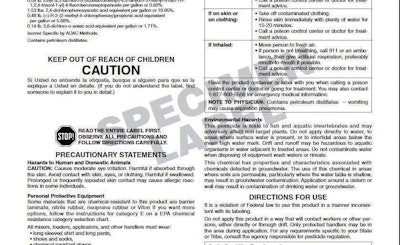
Professionals from all segments of the green industry, including lawn care and golf course turf management, indicated they always read the pesticide label prior to using a product for the first time, according to a Journal of Extension study. However, within the same three groups, the label is only sometimes referred to if they use the product again or if they have prior experience with the product.
Working from the label is critical to a successful application, says Doug Soper, a federal registration manager for PBI/Gordon. Labels change, especially in the area of application rates and target pests. While the changes may be subtle, getting the best control with a chemical hinges on doing things by the book. And more than that – doing it any other way is a violation of federal law.
An authority on labels, Soper explains their importance and how often they change in a Q&A with TLC.
Q: Before a product can come to market, the U.S. Environmental Protection Agency (EPA) not only has to approve the product, but also has to accept the label. Describe the process of getting the label accepted.
A: The product acceptance and label acceptance are not separate events. The results of various toxicology, environmental, product chemistry and efficacy studies that we submit to support registration directly affect the label text in, for example, the precautionary statements, personal protective equipment requirements and maximum use rates. When the EPA grants a registration, it includes acceptance of the whole thing — including the label.
Q: How long does this take?
A: It depends on whether the product contains a new active ingredient (AI). For products with new AIs, federal registration may take up to three years after all of the necessary studies are completed. On the other hand, many new products contain AIs that are already registered but at different concentrations or in a different type of formulation. In this situation, it may take eight months to receive EPA acceptance.
You are missing a big piece, though. The Federal Insecticide, Fungicide and Rodenticide Act (FIFRA) provides for joint regulation of pesticides by the federal government and the states. After the EPA registers a product, the container label is created and sent to all states. In some states, the product is registered almost immediately. In others, California and New York especially, a product with new AIs may take another year to register, and a product with AIs that are already registered may take around six months.
Q: What would you say to encourage landscapers to always consult the label – even if they are simply restocking their favorite product?
A: Information on pesticide labels changes. Some of it may not affect a particular user, but plenty of changes are important. New protective equipment guidelines, new maximum use rates and sometimes restrictions are eased. In my experience, the biggest complaints about reading labels are regarding the long labels. I think the longer labels, in general, are getting better and more organized. And this helps the reader focus on those parts that directly affect him.
It’s the law
Federal laws and regulations set the standards for pesticide use. States use these as a starting point but also have the right to be stricter than federal law. At the national level, the U.S. Environmental Protection Agency (EPA) regulates the use of pesticides under the mandate of the Federal Insecticide, Fungicide and Rodenticide Act (FIFRA).
According to the FIFRA, users cannot use any pesticide in a manner that is inconsistent with the label. For example, they can only use a product on sites that appear on the label. In addition, this provision means the product can’t be used at a rate that is greater than that specified on the label. At the same time, using a product at less than label rates may encourage the development of resistance of the pests to the pesticide.
While the penalties for not following the label vary by state, failure to follow label directions can at the least result in a fine ($5,000 to $10,000 per offense) and could even include mandatory jail time.
EDITOR’S NOTE: This article was written by Cindy Ratcliff.










